-
Paper Information
- Previous Paper
- Paper Submission
-
Journal Information
- About This Journal
- Editorial Board
- Current Issue
- Archive
- Author Guidelines
- Contact Us
Journal of Nuclear and Particle Physics
p-ISSN: 2167-6895 e-ISSN: 2167-6909
2015; 5(1): 10-14
doi:10.5923/j.jnpp.20150501.02
Interaction of 28Si Ions with Emulsion Nuclei at Momentum 4.5 AGeV/c
A. Abd EL-Daiem
Physics Department, Faculty of science, Sohag University, Sohag, Egypt
Correspondence to: A. Abd EL-Daiem , Physics Department, Faculty of science, Sohag University, Sohag, Egypt.
| Email: |  |
Copyright © 2015 Scientific & Academic Publishing. All Rights Reserved.
The main experimental characteristics multiplicity have been investigated from 28Si with emulsion at 4.5 GeV/c. The nucleus-nucleus collisions are given in the energy interactions of 4He, 24Mg and 28Si with emulsion nuclei at nearly the same. On the other hand the relativistic energy (a few GeV/nucleon) is a special energy, at which the nuclear limiting fragmentation applies initially. Therefore, the target fragmentation is studied by selecting samples of inelastic interactions events having no emission of relativistic hadrons'. The multiplicity distribution of the produced target fragments are studied. The angular distribution of target fragmentations particles, grey and black of the interaction of 28Si emulsions, shows statically significant peak which have been attributed to a collective phenomenon.
Keywords: Multiplicity secondary particles, Multiplicity correlation and angular distribution
Cite this paper: A. Abd EL-Daiem , Interaction of 28Si Ions with Emulsion Nuclei at Momentum 4.5 AGeV/c, Journal of Nuclear and Particle Physics, Vol. 5 No. 1, 2015, pp. 10-14. doi: 10.5923/j.jnpp.20150501.02.
Article Outline
1. Introduction
- The interest in high-energy nucleus-nucleus collision has greatly important during a few recent years. It allows one to obtain some information about the mechanisms of the multiparticle production and the structure of hot nuclear matter [1]. From the participant spectator model [2], the quark gluon plasma (quark matter) [1] will be formed in the participant between the projectile and the target at very high incident energies and a liquid gas phase transition will occur in the spectator [3]. The interaction between the incident beam and the target emulsion nuclei is called central when the impact parameter is less than the absolute value of the difference between the interacting radii of two nuclei, i.e. b< 1Rp-Rt1 where Rp and Rt are the projectile and target nuclei radii respectively. Such events are characterized by large multiplicities of the generated particles and the emitted target fragments. The emission of particles is symmetric with respect to the direction of the incident beam. In central collision all projectile nucleons are participants and no projectile spectators. The study of the correlation in complete destruction of Ag (Br) emulsion nuclei is very interesting. The most of these interactions are due to central collision. Central collision provides a unique opportunity to investigate the consequents of nuclear compression, such as hydrodynamic effects [4-6]. Also one can study the mechanism of multiparticle production [7-12], and also obtain valuable information on the excitation and subsequent decay of residual target nucleus. This study is restricted to events such that Nh >27 (Nh=Ng+Nb), i.e. to central collision of 28Si with Ag (Br), where Nh is the number of heavy target fragments, Ng is the number of grey particles and Nb is the black particles.
2. Experimental Details
- Three stacks of NIFKI-Br2 nuclear emulsion with dimensions of 20cm x 10cm x 600μm were irradiated by 28Si, 24Mg (4.5AGeV/c) and 4He (4.1AGeV/c) beam at synchrophastron in Dubna, Russia. Along the track double scanning, fast in the forward direction and slows in the backward one, was carried out using a total magnification of about 1500x. Here we could carefully extract sufficient number of statistical events. The experimental means free path λ were found to be 8.7±0.3, 10.2±0.6 and 19.9±0.1 for the interactions of 28Si, 24Mg and 4He with emulsion, respectively. The tracks of the emitted secondary charged particles in each event were classified to traditional emulsion criteria [13, 14] as follows: (a) shower tracks are singly charged relativistic particles with relative ionization I/I0 ≤1.4, were I is the track ionization and I0 is the plateau ionization for single charged minimum ionization particles. Their multiplicity was denoted by ionization Ns, (b) Grey tracks having a range of L ≥ 3 mm in emulsions and relative ionization I/I0 ≤1.4. These tracks are mostly due to protons with kinetic energy in the range 26-400 MeV. Their multiplicity denoted by Ng, (c) Black tracks, those are having range of L ≥ 3 mm corresponding to protons with kinetic energy ≤ 26 MeV. They are mainly due to evaporated target fragments. T heir multiplicity is denoted by Nb. In each event, the black and grey tracks together are called heavily ionizing tracks. Their multiplicity is denoted by (Nh = Ng + Nb), and (d) projectile fragments, PF`s are emitted with an angle θLab ≤ 30, with respect to the direction of incidence. They are characterized by no change in their ionization for at least 2cm from the interaction point. The single charged fragments emitted in the forward fragmentation cone were subjected to rigorous multiple scattering measurements for the momentum determination in order to distinguish them from the produced pious.
3. Secondary Particle Multiplicities
- In figure. (1a-c), we show the normalized multiplicity distribution of shower, grey and black particles for 28Si-and 24Mg (present work) and 4He [15] with emulsion nuclei at (4.5 and 4.1AGeV/c) respectively. From these figures and the results of the developed modified cascade evaporation model for A-A collision (Kawrakow et al., 1992) [16], we can conclude that, as the number of interacting projectile nucleons increase, the values of Ns slightly increases, which leads to an slightly increase in the average multiplicity of the produced shower particles, <Ns>. This may be indicate that the A-A interactions is a superposition of nucleon – nucleon interaction [17].
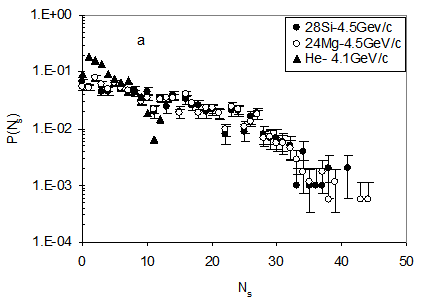 | Figure 1a. The multiplicity distribution of shower particles for the ineraction of 28Si(closed circle), 24Mg(open circle) at 4.5AGeV/c and 4He(closed triangle) at 4.1AGeV/c with emulsion |
 | Figure 1(b-c). The multiplicity distribution of grey and black particles for the interactions of 28Si, 24Mg(4.5AGeV/c) and 4He(4.1) with emulsion respectively |
4. Multiplicity Correlations
- The correlation between the shower (s) and others i.e. black (b), grey (g) and heavily ionization (h) track multiplicities like <Ni>=aij + kijNj (i≠j) as shown in figure (2). The best fitting of the present data are: <Ng>=0.56Ns+2.25, <Nb>=0.33Ns+1.75 and <Nh>=0.89Ns+3.99. We notice that the inclination is positive which is practically signifying the appreciable dependence of <Ng>, <Nb> and <Nh> on Ns. In figure (3a-c) which shows the dependence of <Ns>, <Ng>, and <Nb> on the size of the target fragmentation Nh in heavy ion interactions. This might reflect the cascading process, which is more, pronounced and consequently the energy deposition within the interaction volume is large in the heavy ion interaction [18]. The dependence of the mean number of black track on Ng is non-linear throughout the energy range 6.2GeV to 400GeV in the interaction of proton with emulsion [19]. This is hold for our data of 28Si with emulsion interaction at 4.5GeV/c with emulsion as shown in figure (4). The best fit for Ng<11 take the form: <Nb>=0.752Ng+0.414. For Ng≥10, a saturation of <Nb>-Ng correlation is reached. The correlation does not depend on the nature of the incident particle.
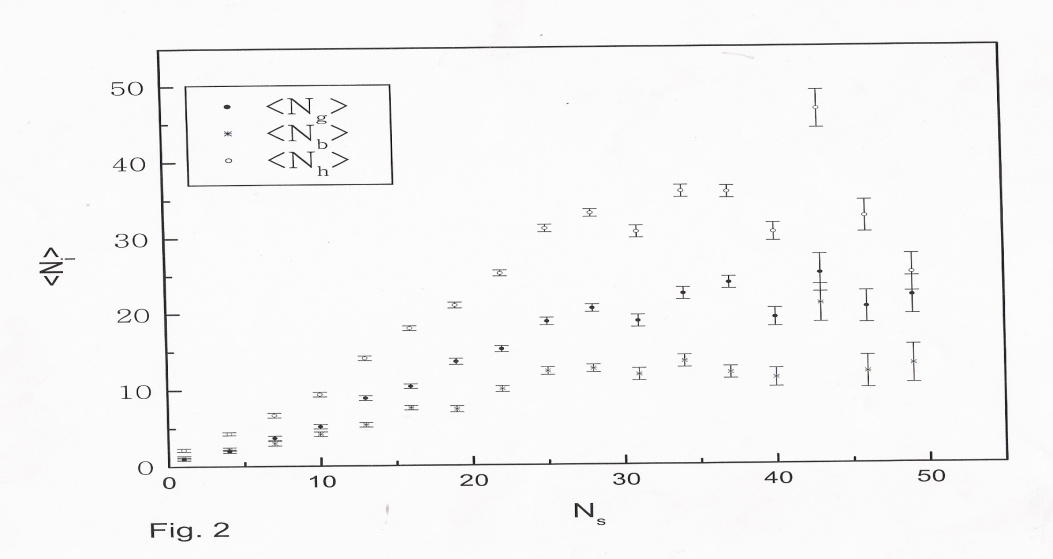 | Figure 2. The dependence of the mean number of heavy tracks <Ni>,i=g,b,h, on the shower particles Ns of the interaction of 28Si-emulsion nuclei |
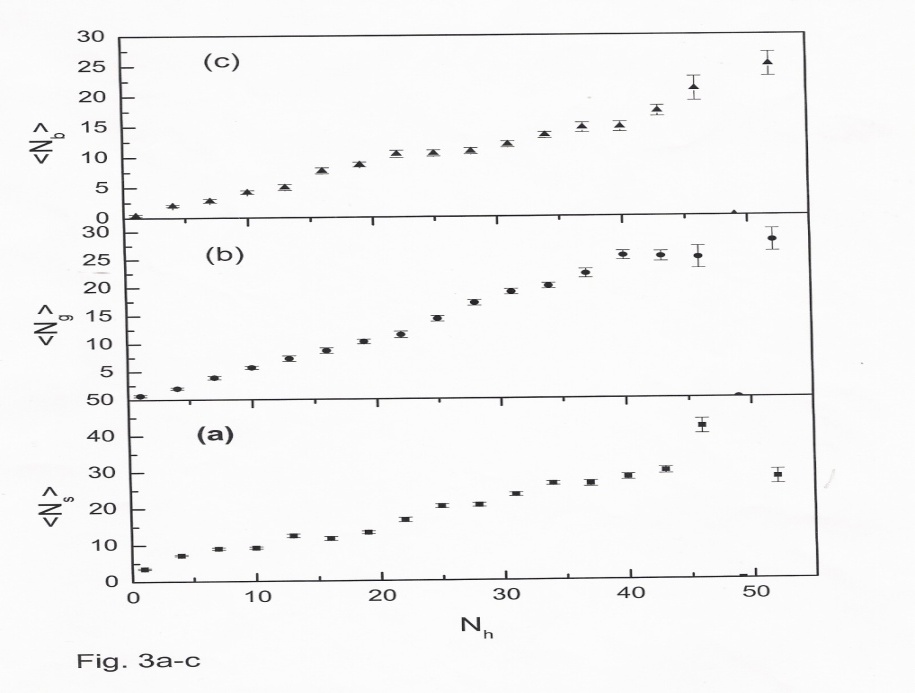 | Figure 3(a-c). The dependence of <Ng>, <Nb> and <Ns>, on the size of the target fragmentation Nh for 28Si-emulsion respectively |
 | Figure 4. The dependence of the mean number of black track <Nb> on Ng for 28Si-with emulsion collision |
5. Angular Distributions of Target Fragments
- Figure(5a) presents the angular distribution of grey particles emitted in central collision of 28Si ions with emulsion at 4.5 GeV/c per nucleon. This distribution compared with the distribution of grey particles from all 28Si interaction is presented in the same figure. It is seen as has been in many papers [6-12] and [20-26], that the angular distribution of grey particles tracks is very weakly dependent on variation of the projectile mass, the primary energy and the target mass. The number of participant nucleons increases as the volume of the cylinder cut by the projectile in the target nucleus increases as the mass of the projectile increases, the cross sectional area of this cylinder increased consequently the number of participants also increases. The size of the target nucleus is limited and consequently the number of evaporated particles decreases when Ng increases. Figure(5b) shows the angular distribution of black particles i.e. tracks with range less than or equal to 3000mm, which is equivalent to proton kinetic energy ≤ 27 MeV emitted from central collision and all interactions of 28Si ions, within statistical errors the distributions are consistent with each other. The target fragment angular distributions show no statistically significantly peak which could be attributed to shock wave.
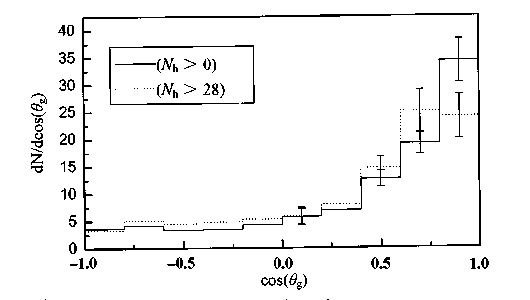 | Figure 5a. The angular distribution of grey particles emitted in central collision and all interactions of 28Si ions with emulsion at 4.5 GeV/c |
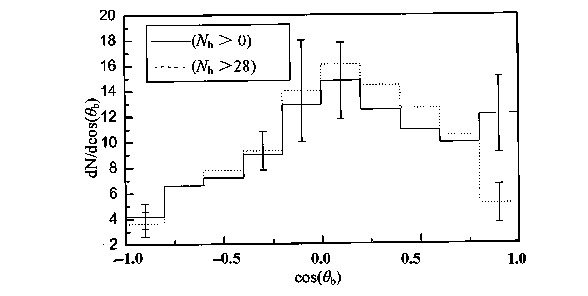 | Figure 5b. The angular distribution of black particles emitted from central collision and all interactions of 28Si ions with emulsion at 4.5 GeV/c |
6. Conclusions
- From the investigation of particles emitted in the interaction of 28Si emulsion collisions, we can make the following conclusions:1. The multiplicity distribution of shower, grey and black particles of the present data for the interactions of 28Si and 24Mg (4.5AGeV/c) and the other experimental one for 4He (4.1AGeV/c) with emulsion, are slightly different according to the different of their average multiplicities. 2. As the number of interacting projectile nucleons increase from 28Si to 4He the values of Ns increases which leads to an increasing of <Ns>. This may indicate the possibility of considered that nucleus-nucleus interaction is a superposition of nucleon – nucleon interaction. 3. The multiplicity correlations have observed the following: for shower particles Ns with the other averages <Ng>, < Nb >, and <Nh> in emulsion is given by the relation: <Ni>=aij +kijNj (i≠j). The dependence of <Ns>, <Ng>, and <Nb> on the size of the target fragmentation Nh in heavy ion interactions might reflect the cascading process. The dependence of <Nb> on Ng is non-linear, independent on the nature of the incident particles.4. The angular distribution of target fragments are independent on the projectile mass, the impact parameter and on the target nucleus.5. The target fragments angular distribution show no statistically significant peak which could be attributed to shock wave.
ACKNOWLEDGMENTS
- We would like to thanks prof. Dr. Hesham Mansour for critical reading of the manuscript useful discussions and valuable information. This work is dedicated to the memory of prof. Dr. A. El-Naghy.
 Abstract
Abstract Reference
Reference Full-Text PDF
Full-Text PDF Full-text HTML
Full-text HTML